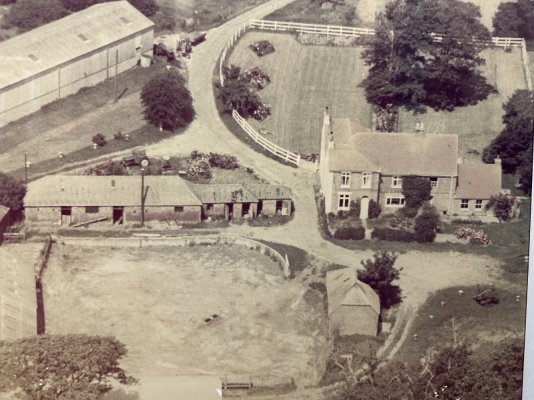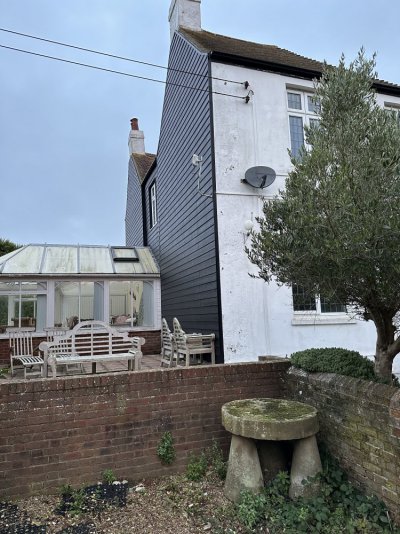Hi all! I'm looking for a bit of guidance on our cellar, and the various issues I believe this is causing to the rest of the house.
The property is an old farm house (constructed 1820) with no damp course, a large cellar runs from front to back of the house (approx 70m2) appears to be built from chalk blocks.
A conservatory and patio on the SW side of the house (photo 2) was constructed about 30+ years ago, where previously a road ran, the conservatory and patio were built up to ground floor level of the house (the road was perhaps a foot or so lower than this at a guess). The road was sloped towards a pond (bottom right hand corner of one of the photos).
The cellar currently floods - water pours in like a tap at a low level (near the bottom of the cellar wall) below where the patio stands on the SW side of the house. I'm guessing the cellar hasn't always flooded like this, there are coal shoots into the cellar where the conservatory now stands (which would have been off the road which is now gone) - suggesting that it perhaps didn't flood (I'm guessing you don't tip coal into a wet or very damp cellar).
Our consideration is whether to remove the patio (and conservatory) and see if it is possible to dig down to the low cellar level and stop the water coming in to the cellar from the outside. I note a different thread on here about a Zebcolm trench - I guess this is similar to our thoughts. Would the main house wall and chalk cellar be susceptible to collapse if we removed the earth butting up to it (patio/conservatory).
We recently spoke to a Timber/Damp specialist who suggested some ideas, but these were all mostly based around tanking and extracting the water from the cellar, which I felt doesn't really tackle the root of the problem. I'm looking to see if there is a solution whereby stopping the water from the outside.
Further to this, the cellar has poor ventilation (two tiny - standard brick sized air bricks for a 70m2 cellar - one front and one back), is very damp (lots of condensation) and very mouldy. There are signs of woodworm in the cellar and room above. The room above also suffers from damp.
There are signs of wear in the chalk bricks from the flooding.
The wall on the SW side of the property was cladded a few years ago, I am wondering if this has made the issues worse as the wall is less “breathable”?
You can see the paint is flaking to the depth of the wall on the cladding side, suggesting that the wall is damp.
My questions,
1, would increasing the ventilation into the cellar help ease the mould and damp? Or could the addition of more cold air make things worse (eg more fluctuation in house temperature?)
2, if 1 would help, is this likely to help with the woodworm issue (as well as treating it).
3, is the cladding helping/hindering/making no difference?
I would also add a pump to try and get rid of any significant excess of water after flooding in the interim.
4, does anyone have any experience with flooding of this type, and does anyone have any opinions?
The consensus amongst "experts" seems to be just get the water out quickly and live with things as they are - otherwise it's lots and lots of cash and no guaranteed solution.
Many thanks in advance - happy to provide additional info, there is probably a lot I've missed.


The property is an old farm house (constructed 1820) with no damp course, a large cellar runs from front to back of the house (approx 70m2) appears to be built from chalk blocks.
A conservatory and patio on the SW side of the house (photo 2) was constructed about 30+ years ago, where previously a road ran, the conservatory and patio were built up to ground floor level of the house (the road was perhaps a foot or so lower than this at a guess). The road was sloped towards a pond (bottom right hand corner of one of the photos).
The cellar currently floods - water pours in like a tap at a low level (near the bottom of the cellar wall) below where the patio stands on the SW side of the house. I'm guessing the cellar hasn't always flooded like this, there are coal shoots into the cellar where the conservatory now stands (which would have been off the road which is now gone) - suggesting that it perhaps didn't flood (I'm guessing you don't tip coal into a wet or very damp cellar).
Our consideration is whether to remove the patio (and conservatory) and see if it is possible to dig down to the low cellar level and stop the water coming in to the cellar from the outside. I note a different thread on here about a Zebcolm trench - I guess this is similar to our thoughts. Would the main house wall and chalk cellar be susceptible to collapse if we removed the earth butting up to it (patio/conservatory).
We recently spoke to a Timber/Damp specialist who suggested some ideas, but these were all mostly based around tanking and extracting the water from the cellar, which I felt doesn't really tackle the root of the problem. I'm looking to see if there is a solution whereby stopping the water from the outside.
Further to this, the cellar has poor ventilation (two tiny - standard brick sized air bricks for a 70m2 cellar - one front and one back), is very damp (lots of condensation) and very mouldy. There are signs of woodworm in the cellar and room above. The room above also suffers from damp.
There are signs of wear in the chalk bricks from the flooding.
The wall on the SW side of the property was cladded a few years ago, I am wondering if this has made the issues worse as the wall is less “breathable”?
You can see the paint is flaking to the depth of the wall on the cladding side, suggesting that the wall is damp.
My questions,
1, would increasing the ventilation into the cellar help ease the mould and damp? Or could the addition of more cold air make things worse (eg more fluctuation in house temperature?)
2, if 1 would help, is this likely to help with the woodworm issue (as well as treating it).
3, is the cladding helping/hindering/making no difference?
I would also add a pump to try and get rid of any significant excess of water after flooding in the interim.
4, does anyone have any experience with flooding of this type, and does anyone have any opinions?
The consensus amongst "experts" seems to be just get the water out quickly and live with things as they are - otherwise it's lots and lots of cash and no guaranteed solution.
Many thanks in advance - happy to provide additional info, there is probably a lot I've missed.


